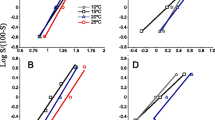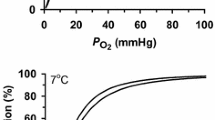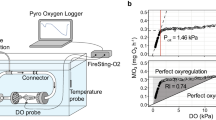Abstract
Habitat perturbations, including dam construction with consequent temperature changes and the introduction of non-native species to California’s mid- to low-elevation streams, have negatively influenced some native fish populations’ historic distribution and abundance. Populations of hardhead, Mylopharodon conocephalus (Cyprinidae), have experienced such population declines, but environmental temperature effects on this large (to 60 cm SL), native species are poorly documented. We measured temperature effects on in vitro blood-oxygen affinity and equilibrium curve shape, key dynamics of the species’ oxygen-transport system, derived from blood collected from wild-caught hardhead. Over an 11–30 °C temperature range, the half-saturation value (P50, an inverse measure of affinity) increased with the temperature from 0.51 to 1.80 kPa for low-PCO2 (“arterial”) treatments and from 2.02 to 2.92 kPa for high-PCO2 (“venous”) treatments. The apparent heat of oxygenation (temperature effect) was higher at temperatures > (absolute value) 19 °C. Therefore, hardhead’s blood has a decreased ability to bind oxygen at its gills at temperatures ≥25 °C, compared to that at temperatures ≤19 °C. The hardhead’s Bohr factors (Ф), non-bicarbonate buffer values (β), nucleoside triphosphate (NTP) concentrations, blood oxygen capacities (CBO2), and mildly sigmoid-shaped oxygen equilibrium curves showed no relationship with temperature. Overall, their blood-oxygen equilibria suggest that hardhead can tolerate moderate hypoxia and temperature variations in its environment and that they have some capacity for sustained, high-aerobic activity.

Similar content being viewed by others
References
Albers C, Manz R, Muster D, Hughes GM (1983) Effect of acclimation temperature on oxygen transport in the blood of the carp, Cyprinus carpio. Respir Physiol 52:165–179
Brown LR, Moyle PB (1987) Survey of fishes of mid-elevation streams of the San Joaquin Valley. California Department of Fish and Game, Final Report, Contract C-20607, pp 222
Brown LR, Moyle PB (1993) Distribution, ecology, and status of the fishes of the San Joaquin River drainage, California. Calif Fish Game 79:96–114
Cameron JN (1971) Oxygen dissociation characteristics of the blood of the rainbow trout, Salmo gairdneri. Comp Biochem Physiol A 38:699–704
Cameron JN, Davis JC (1970) Gas exchange in rainbow trout (Salmo gairdneri) with varying oxygen capacity. J Fish Res Board Can 27:1069–1085
Cech JJ Jr, Mitchell SJ, Massingill MA (1979) Respiratory adaptations of Sacramento blackfish, Orthodon microlepidotus (Ayers), for hypoxia. Comp Biochem Physiol 63A:411–415
Cech JJ Jr, Laurs RM, Graham JB (1984) Temperature-induced changes in blood gas equilibria in the albacore, Thunnus alalunga, a warm-bodied tuna. J Exp Biol 109:21–34
Cech JJ Jr, Mitchell SJ, Castleberry DT, McEnroe M (1990) Distribution of California steam fishes: influence of environmental temperature and hypoxia. Environ Biol Fish 29(2):95–105
Cech JJ Jr, Castleberry DT, Hopkins TE (1994) Temperature and CO2 effects on blood O2 equilibria in northern squawfish, Ptychocheilus oregonensis. Can J Fish Aquat Sci 51:13–19
Cushman RM (1985) Review of ecological effects of rapidly varying flows downstream from hydroelectric facilities. N Am J Fish Manag 5:330–339
Dobson GP, Wood SC, Daxboeck C, Perry SF (1986) Intracellular buffering and oxygen transport in the Pacific blue marlin (Makaira nigricans): adaptations to high-speed swimming. Physiol Zool 59:150–156
Eddy FB (1973) Oxygen dissociation curves of the blood of the tench, Tinca tinca. J Exp Biol 58:281–293
Edwards MJ, Martin RJ (1966) Mixing technique for the oxygen–hemoglobin equilibration Bohr effect. J Appl Physiol 21:1898–1902
Frey BJ, Weber RE, van Aardt WJ, Fago A (1998) The haemoglobin system of the mudfish, Labeo capensis: adaptations to temperature and hypoxia. Comp Biochem Physiol B 120:735–742
Grant GC, Maslin PE (1997) Movements and reproduction of hardhead and Sacramento squawfish in a small California stream. Southwest Nat 44:296–310
Greaney GS, Place AR, Cashon RE, Smith G, Powers DA (1980) Time course of changes in enzyme activities and blood respiratory properties of killifish during long-term acclimation to hypoxia. Physiol Zool 53(2):136–144
Grigg GC (1974) Respiratory function of blood in fishes. In: Florkin N, Scheer BT (eds) Chemical zoology. Academic, NY, pp 331–368
Hall FG (1960) A tonometric apparatus for constant flow gas equilibration. J Appl Physiol 15:312–313
Hall DG, Reeves KS (2006) A study of United States hydroelectric plant ownership. Report prepared for National Renewable Energy Laboratory Tribal Energy Program under DOE Idaho Operations Office contract # DE-AC07-05ID14517
Herbold B, Moyle PB (1986) Introduced species and vacant niches. Am Nat 128:751–760
Houston AH (1990) Blood and circulation. In: Schrek CB, Moyle PB (eds) Methods for fish biology. American Fisheries Society, Bethesda, pp 273–322
Jensen FB, Nikinmaa M, Weber RE (1993) Environmental perturbations of oxygen transport in teleost fishes: causes, consequences, and compensations. In: Rankins JC, Jensen FB (eds) Fish ecophysiology. Chapman and Hall, London, pp 161–179
Kaufman RC, Houck AG, Cech JJ Jr (2006) Effects of temperature and carbon dioxide on green sturgeon blood-oxygen equilibria. Environ Biol Fish 76:119–127
Klimley AP, Cech JJ Jr, Thompson LC, Hamilton S (2010) Experimental and field studies to assess pulsed, water flow impacts on the behavior and distribution of fishes in the South Fork of the American River, II (Second Year). University of California Energy Commission, PIER Energy-Related Environmental Research. California Energy Commission. CEC-500-2009-067
Knight NJ (1985) Microhabitats and temperature requirements of hardhead (Mylopharodon conocephalus) and Sacramento squawfish (Ptychocheilus grandis), with notes for some other native California stream fishes. Ph.D. dissertation. Univ. Calif., Davis. pp 161
Moyle PB (2002) Inland fishes of California. University of California Press, Berkeley, p 153
Moyle PB, Baltz DM (1985) Microhabitat use by an assemblage of California stream fishes: developing criteria for instream flow recommendations. Trans Am Fish Soc 114:695–704
Moyle PB, Nichols RD (1973) Ecology of some native and introduced fishes of the Sierra Nevada foothills in central California. Copeia 1973:478–490
Moyle PB, Yoshiyama RM, Williams JE, Wikramanayake ED (1995) Fish species of special concern of California, 2nd edn. California Department of Fish and Game, Sacramento
Myrick CA, Cech JJ Jr (2000) Swimming performance of four California stream fishes: temperature effects. Environ Biol Fish 58:289–295
Pacific Gas and Electric (1985) Pit 3, 4, and 5 Project Bald eagle and fish study. BioSystems Analysis, Inc., University of California, Davis, Wildlife and Fisheries biology, Pacific Gas and Electric Company Dept. of Engineering Research, Final rpt. ca. 250 pp. Pacific Gas and Electric Company, Department of Engineering Research. http://hydropower.inel.gov/hydrofacts/pdfs/a_study_of_united_states_hydroelectric_plant_ownership.pdf
Perez J, Rylander K, Nirchio M (1995) The evolution of multiple hemoglobins in fishes. Rev Fish Biol Fish 5:304–319
Powers EB (1932) The relation of respiration of fishes to environment. Ecol Monogr II:387–473
Powers DA (1980) Molecular ecology of teleost fish hemoglobins: strategies for adapting to changing environments. Am Zool 20:139–162
Powers DA (1983) Adaptation of erythrocyte function during changes in environmental oxygen and temperature. In: Cossins AR, Sheterline P (eds) Cellular acclimatization to environmental change. Cambridge Press, Great Britain
Reeves JE (1964) Age and growth of hardhead minnow, Mylopharodon conocephalus (Baird and Girard), in the American River basin of California with notes on its ecology. M.S. thesis, University of California. pp 90
Riggs A (1970) Properties of fish hemoglobins. In: Hoar WS, Randall DJ (eds) Fish physiology: the nervous system, circulation, and respiration. Academic, New York
Root RW (1931) The respiratory function of the blood of marine fishes. Biol Bull 61:427–456
Rutjes HA, Nieveen MC, Weber RE, Witte F, Van den Thillart GEEJM (2007) Multiple strategies of lake Victorian cichlids to cope with lifelong hypoxia include hemoglobin switching. Am J Physiol Regul Integr Comp Physiol 293:R1376–R1383
Scheid P, Meyer M (1978) Mixing technique for study of oxygen–hemoglobin equilibrium: a critical evaluation. J Appl Physiol Respir Environ Exercise Physiol 45:818–822
Soivio A, Westman K, Nyholm K (1972) Improved method of dorsal aorta catheterization: haematological effects followed for three weeks in rainbow trout (Salmo gairdneri). Finn Fish Res 1:11–21
Soivio A, Nyholm K, Westman K (1975) A technique for repeated sampling of the blood of individual resting fish. J Exp Biol 62:207–217
Tucker VA (1967) Method for oxygen content and dissociation curves on microliter blood samples. J Appl Physiol 23:410–414
Weber RE (1996) Hemoglobin adaptations in Amazonian and temperate fish with special reference to hypoxia, allosteric effectors, and functional heterogeneity. In: Val AL, Almeida-Val VFM, Randal DJ (eds) Physiology and biochemistry of the fishes of the amazon (chapter 7). INPA, Brazil, pp 75–90
Weber RE, Jensen FB (1988) Functional adaptations in hemoglobins from ectothermic vertebrates. Ann Rev Physiol 50:161–179
Weber RE, Wells RMG (1989) Hemoglobin structure and function. In: Wood SC (ed) Comparative pulmonary physiology, current concepts. Dekker, New York
Wood SC, Lenfant C (1979) Oxygen transport and oxygen delivery. In: Wood SC, Lenfant C (eds) Evolution of respiratory processes. Marcel Dekker, NY
Young P, Cech JJ Jr, Thompson LC (2011) Hydropower-related pulsed-flow impacts on stream fishes: a brief review, conceptual model, knowledge gaps, and research needs. Rev Fish Biol Fish 21(4):713–731. doi:10.1007/s11160-011-9211-0
Acknowledgments
We thank Paciencia Young for her assistance in identifying the need for this study; Kevin Thomas of the California Department of Fish and Game for assistance with our Scientific Collection Permit; Kevin Thomas, Clint Garman, Jay Rowan, and Robert Vincik of CDFG, Jann Williams of the US Forest Service—Eldorado National Forest, Rob Aramayo of Garcia and Associates, Mariska Obedzinski of California Sea Grant Extension Program, and Shawn Chase of Sonoma County Water Agency for assistance with identification of fish capture sites; Bill Center of Camp Lotus for access to the Nugget property and Bill Williams and Ed Shelton of Pacific Gas and Electric for access upstream of the Chili Bar Dam facility; Gale Higgins, Darold Perry, and Dave Hanson for providing access to Sacramento Municipal Utility District hydropower facilities; Halley Nelson, John Reardon, Brian Williamson, Oliver Patton, Bethany DeCourten, Jamilynn Poletto, Natalie Ho, Denisse Jauregui, Felipe La Luz, and Jennifer Yu with assistance in fish capture and husbandry; the Upper American River Foundation, Granite Bay Flycasters, and the Sac-Sierra Chapter of Trout Unlimited for assistance with hardhead capture; Daniel Anderson for use of his boat for hardhead capture; and E.P. Scott Weber and Paul Lutes for their advice on fish husbandry. This research was funded by California Energy Commission Public Interest Energy Research (PIER) grant PIR-08-029 and the University of California Agricultural Experiment Station (grant no. 2098-H to N.A.F.). We thank our CEC project manager Joseph O’Hagan for guidance throughout the project.
Author information
Authors and Affiliations
Corresponding author
Rights and permissions
About this article
Cite this article
Kaufman, R.C., Coalter, R., Nordman, N.L. et al. Effects of temperature on hardhead minnow (Mylopharodon conocephalus) blood-oxygen equilibria. Environ Biol Fish 96, 1389–1397 (2013). https://doi.org/10.1007/s10641-013-0116-8
Received:
Accepted:
Published:
Issue Date:
DOI: https://doi.org/10.1007/s10641-013-0116-8




